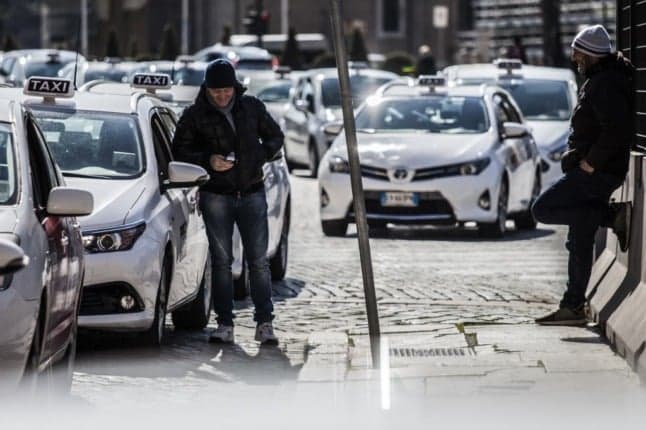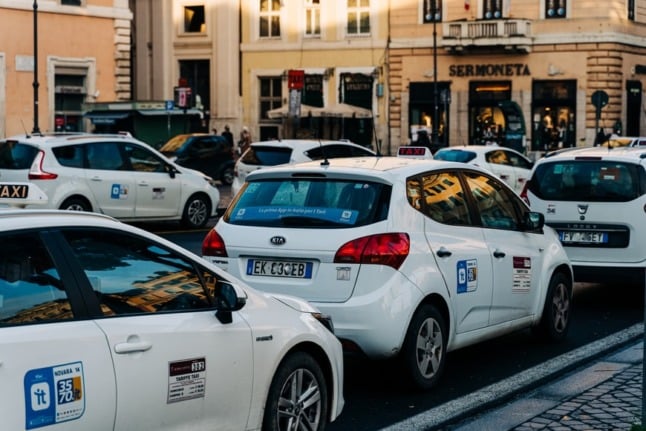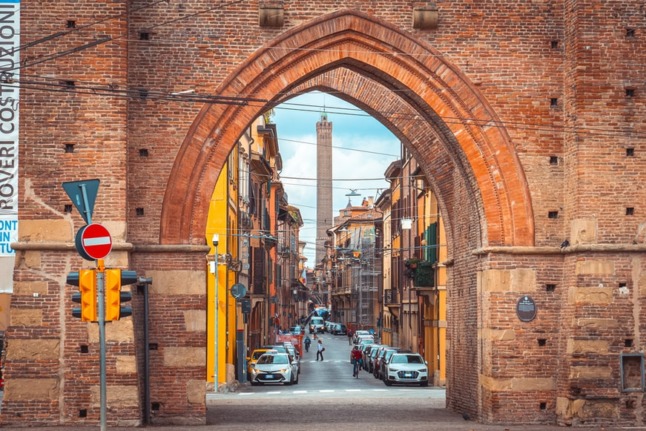How to get a discount on taxi fares in Italian cities

The Italian government has allocated funds for residents of Rome and other cities to receive discounted fares on taxis and private driver car rentals. Here’s how to access the vouchers depending on where you live.
As part of its efforts to kickstart Italy’s Covid-hit economy and protect the health of its most vulnerable residents, the government has allocated funds for cities across the country to offer subsidised private transport services to residents.
The idea is to provide a boost to taxi drivers, who have suffered dramatic losses to their income over the past 18 months, while increasing the private travel options for vulnerable individuals who may be uncomfortable using public transport.
The 'buoni viaggio' ('travel vouchers') scheme will last until at least the end of this year, when the current state of emergency is due to expire, with the possibility of an extension if the state of emergency is extended.
With financing from the government's 2021 Relaunch Decree and Support Decree to support struggling businesses affected by the pandemic, the funds were first disbursed in March, but so far only some cities have implemented discount schemes.
Rome, Milan, Florence, Parma and Bologna are among those participating.
Each city council is responsible for administering the programme itself, which means each city has a different procedure for residents to access the funds and different rules on who is eligible.
Here’s how to apply for the discount depending on where you live:

Photo: Gabriella Clare Marino/Unsplash
Rome
Rome has put together arguably the most generous package of any city, with all adult women eligible for a 50% discount on taxi fares - as long as they are city residents.
Men over the age of 65 and disabled people over the age of 18 who are not already using different subsidized transport services can also access the discount.
Residents wanting take advantage of the scheme need to go to the site buoniviaggioroma.romamobilita.it. You will need either your SPID, National Services Card (CNS), or Regional Services Card (CRS) number to sign up.
READ ALSO: Italian bureaucracy: What is a SPID and how do you get one?
On the day you want to use the voucher, you will need to download a QR code from the website. You will need to make sure you book a taxi or private car rental driver that has signed up to the scheme.
When the journey is over, you should show your QR code to the driver, who will scan it to calculate your discounted fare. The payment must be made by debit or credit card (not cash).
The discount is capped at €20, so if your total fare is €50, you will pay €30; if it costs €16, you will pay €8. Each resident can use up to two vouchers per day, and access up to €400 worth of discounts per month.

Photo: Mikita Yo/Unsplash
Milan
Milan is offering discounted rides to those who are:
- disabled, medically vulnerable, or have reduced mobility
- "belonging to families most exposed to the economic effects" of the pandemic
- unemployed or with an ISEE (Equivalent Economic Situation Indicator) of €28,000 or below
To sign up, residents should go to the 'Milano Aiuta' (Milan Helps) section of the city council's website at this address: www.comune.milano.it/web/milanoaiuta/buoni-viaggio-taxi-e-ncc and go to the 'Click here to submit your application' link.
Applicants will need to sign an online declaration form confirming that they meet the criteria for receiving the discount, and the city says it reserves to the right to conduct checks.
The council's website says there is a ceiling of €200 on the vouchers.
The 50% total discount with a €20 per journey cap remains in place.
READ ALSO: Italy’s spa bonus: How you can claim €200 towards a relaxing break
Florence
Florence is providing the discount in the form of actual voucher booklets, and a wide range of people are eligible to apply, namely:
- anyone over the age of 65
- people with certified disabilities or medical issues
- pregnant women
- health workers and school staff needing transport to and from work
- the unemployed
Those who want to apply for a booklet should go to the portal buoniviaggio.055055.it, and will need a SPID, CNS, or CIE (Carta di identità elettronica, or Electronic Identity Card) to sign up.
Once approved, a booklet of 20 €5 vouchers worth a total of €100 will be sent to the applicant's home. A passenger can use up to four vouchers per trip (so €20 total).
As soon as the first request has been approved, the applicant can apply for a second booklet of a further 20 vouchers worth €100.
READ ALSO: Italy’s building bonus: Can you really claim back the cost of renovating property?

Photo: Petr Slováček/ Unsplash
Bologna
Bologna offers discounts to people with disabilities or illnesses or those who have reduced mobility, including the elderly and pregnant women; as well as those who have been financially impacted by the pandemic.
To apply, residents should go to the website or sign up via the Bologna Welfare app.
They should then download the city's 'Roger' app, where they can buy journeys in advance with a total value of €40, €80, or €100, paying only half the value of the trip (so €20 for a €40 trip, €40 for a €80 trip, or €50 for a €100 trip).
Passengers subscribed to the scheme should let the taxi company know at the time of booking that they wish to pay via the Roger app.
Those who don't want to use the Roger app can email the taxi service they want to book with, attaching a copy of their proof of registration to the scheme, and deal with the company individually.
The vouchers can be bought up until December 30th, 2021, and used until June 30th, 2022.
Parma
Parma is offering the scheme to residents who are:
- aged over 75
- have medium to ever disabilities or mobility issues
- are pregnant
- have an ISEE of less than €28,000, can demonstrate that they have been significantly financially impacted by the pandemic, and haven't already received financial support in the form of the 'citizen's income' or 'emergency income'.
Applicants will need to sign up with their SPID via the following form on the Parma city council's website.
Successful applicants are entitled to up to €150 euros, with 50% discount on journeys and a €20 per trip cap. They will receive a QR code via email, which they can display to taxi drivers to receive the discount.
As in other cases, passengers should let the driver know at the time of booking that they want to make use of the discount.
The discount can be used up until December 31, 2021 for Parma's residents.
Comments
See Also
As part of its efforts to kickstart Italy’s Covid-hit economy and protect the health of its most vulnerable residents, the government has allocated funds for cities across the country to offer subsidised private transport services to residents.
The idea is to provide a boost to taxi drivers, who have suffered dramatic losses to their income over the past 18 months, while increasing the private travel options for vulnerable individuals who may be uncomfortable using public transport.
The 'buoni viaggio' ('travel vouchers') scheme will last until at least the end of this year, when the current state of emergency is due to expire, with the possibility of an extension if the state of emergency is extended.
With financing from the government's 2021 Relaunch Decree and Support Decree to support struggling businesses affected by the pandemic, the funds were first disbursed in March, but so far only some cities have implemented discount schemes.
Rome, Milan, Florence, Parma and Bologna are among those participating.
Each city council is responsible for administering the programme itself, which means each city has a different procedure for residents to access the funds and different rules on who is eligible.
Here’s how to apply for the discount depending on where you live:

Rome
Rome has put together arguably the most generous package of any city, with all adult women eligible for a 50% discount on taxi fares - as long as they are city residents.
Men over the age of 65 and disabled people over the age of 18 who are not already using different subsidized transport services can also access the discount.
Residents wanting take advantage of the scheme need to go to the site buoniviaggioroma.romamobilita.it. You will need either your SPID, National Services Card (CNS), or Regional Services Card (CRS) number to sign up.
READ ALSO: Italian bureaucracy: What is a SPID and how do you get one?
On the day you want to use the voucher, you will need to download a QR code from the website. You will need to make sure you book a taxi or private car rental driver that has signed up to the scheme.
When the journey is over, you should show your QR code to the driver, who will scan it to calculate your discounted fare. The payment must be made by debit or credit card (not cash).
The discount is capped at €20, so if your total fare is €50, you will pay €30; if it costs €16, you will pay €8. Each resident can use up to two vouchers per day, and access up to €400 worth of discounts per month.

Milan
Milan is offering discounted rides to those who are:
- disabled, medically vulnerable, or have reduced mobility
- "belonging to families most exposed to the economic effects" of the pandemic
- unemployed or with an ISEE (Equivalent Economic Situation Indicator) of €28,000 or below
To sign up, residents should go to the 'Milano Aiuta' (Milan Helps) section of the city council's website at this address: www.comune.milano.it/web/milanoaiuta/buoni-viaggio-taxi-e-ncc and go to the 'Click here to submit your application' link.
Applicants will need to sign an online declaration form confirming that they meet the criteria for receiving the discount, and the city says it reserves to the right to conduct checks.
The council's website says there is a ceiling of €200 on the vouchers.
The 50% total discount with a €20 per journey cap remains in place.
READ ALSO: Italy’s spa bonus: How you can claim €200 towards a relaxing break
Florence
Florence is providing the discount in the form of actual voucher booklets, and a wide range of people are eligible to apply, namely:
- anyone over the age of 65
- people with certified disabilities or medical issues
- pregnant women
- health workers and school staff needing transport to and from work
- the unemployed
Those who want to apply for a booklet should go to the portal buoniviaggio.055055.it, and will need a SPID, CNS, or CIE (Carta di identità elettronica, or Electronic Identity Card) to sign up.
Once approved, a booklet of 20 €5 vouchers worth a total of €100 will be sent to the applicant's home. A passenger can use up to four vouchers per trip (so €20 total).
As soon as the first request has been approved, the applicant can apply for a second booklet of a further 20 vouchers worth €100.
READ ALSO: Italy’s building bonus: Can you really claim back the cost of renovating property?

Bologna
Bologna offers discounts to people with disabilities or illnesses or those who have reduced mobility, including the elderly and pregnant women; as well as those who have been financially impacted by the pandemic.
To apply, residents should go to the website or sign up via the Bologna Welfare app.
They should then download the city's 'Roger' app, where they can buy journeys in advance with a total value of €40, €80, or €100, paying only half the value of the trip (so €20 for a €40 trip, €40 for a €80 trip, or €50 for a €100 trip).
Passengers subscribed to the scheme should let the taxi company know at the time of booking that they wish to pay via the Roger app.
Those who don't want to use the Roger app can email the taxi service they want to book with, attaching a copy of their proof of registration to the scheme, and deal with the company individually.
The vouchers can be bought up until December 30th, 2021, and used until June 30th, 2022.
Parma
Parma is offering the scheme to residents who are:
- aged over 75
- have medium to ever disabilities or mobility issues
- are pregnant
- have an ISEE of less than €28,000, can demonstrate that they have been significantly financially impacted by the pandemic, and haven't already received financial support in the form of the 'citizen's income' or 'emergency income'.
Applicants will need to sign up with their SPID via the following form on the Parma city council's website.
Successful applicants are entitled to up to €150 euros, with 50% discount on journeys and a €20 per trip cap. They will receive a QR code via email, which they can display to taxi drivers to receive the discount.
As in other cases, passengers should let the driver know at the time of booking that they want to make use of the discount.
The discount can be used up until December 31, 2021 for Parma's residents.
Join the conversation in our comments section below. Share your own views and experience and if you have a question or suggestion for our journalists then email us at [email protected].
Please keep comments civil, constructive and on topic – and make sure to read our terms of use before getting involved.
Please log in here to leave a comment.